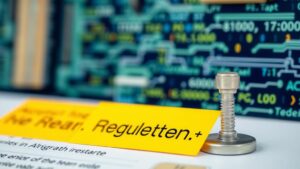Spotlighting the Power of Data
Data-driven insights are transforming the way we approach investing. Here’s how algorithms are reshaping the rules.
Avoiding Data Snooping Bias in Backtesting
In the world of finance and algorithmic trading, the importance of backtesting cannot be overstated. It allows traders and analysts to evaluate their strategies using historical data before risking real capital. However, a common pitfall in this process is data snooping bias, which can lead to misleading results and poor decision-making. In this article, we will explore what data snooping bias is, its implications, and practical strategies to avoid it, ensuring that your backtesting efforts yield reliable and actionable insights.
Data snooping bias occurs when a model is excessively tuned to historical data, leading to overfitting and a false sense of security regarding its predictive power. This phenomenon can arise in various forms during the backtesting process, particularly when researchers unintentionally exploit the same dataset multiple times.
Understanding the Mechanics of Data Snooping
- Overfitting**: The model captures noise instead of underlying patterns.
- Multiple Testing**: Conducting numerous tests on the same dataset increases the likelihood of finding statistically significant results by chance.
- Data Leakage**: Using information from the future or from the same dataset that should not influence the model can lead to unrealistic expectations.
These elements contribute to a scenario where a strategy appears successful in backtesting but fails in real-world applications.
The Implications of Data Snooping Bias
Ignoring data snooping bias can have severe consequences for traders and financial analysts. Here are some key implications:
- **False Confidence**: A backtested strategy may show positive returns, leading traders to believe it will perform well in live markets.
- **Financial Losses**: Implementing a flawed strategy can result in significant financial losses.
- **Erosion of Credibility**: A trader or analyst known for unreliable strategies can lose credibility, affecting future opportunities.
- **Misallocation of Resources**: Time and capital may be wasted on strategies that are not robust or replicable.
Recognizing Data Snooping Bias
To effectively combat data snooping bias, it’s crucial to recognize its signs. Here are some indicators:
Signs of Data Snooping Bias
- High Sharpe Ratios**: An unusually high Sharpe ratio in backtested results can be a red flag.
- Unrealistic Assumptions**: If the strategy relies on unrealistic assumptions about market behavior, it may be a product of data snooping.
- Complex Models**: Overly complex models that require extensive parameter tuning may indicate excessive data fitting.
- Lack of Out-of-Sample Testing**: Results that do not include out-of-sample testing are often unreliable.
Strategies to Avoid Data Snooping Bias
To minimize the risk of data snooping bias in backtesting, traders should implement a series of best practices. Here’s how to develop a robust backtesting framework:
1. Use Out-of-Sample Testing
Out-of-sample testing involves dividing your dataset into training and testing segments. The model is trained on one portion and then validated on another that it hasn’t seen before.
- Training Set**: Used to build the model.
- Validation Set**: Used to test the model’s performance.
- Test Set**: A final, untouched dataset to confirm the model’s predictive power.
2. Apply Walk-Forward Analysis
Walk-forward analysis is a more dynamic approach to backtesting. Instead of relying on static datasets, this method involves continually updating the model as new data becomes available.
- Rolling Window**: Update the model at regular intervals.
- Dynamic Re-optimization**: Re-optimize the model as new data is introduced.
3. Limit Parameter Tuning
Excessive parameter tuning can lead to overfitting. To avoid this, consider the following:
- Use a Fixed Set of Parameters**: Establish a baseline model with fixed parameters.
- Employ Cross-Validation**: Validate the model across different segments of data to ensure robustness.
4. Incorporate Robustness Testing
Robustness testing evaluates how sensitive the model is to changes in its parameters. This can help ensure that it performs well under various market conditions.
- Stress Testing**: Test the model under extreme market conditions.
- Scenario Analysis**: Assess performance across different hypothetical scenarios.
5. Be Mindful of Look-Ahead Bias
Look-ahead bias occurs when future information is inadvertently used in the model. To mitigate this:
- Strict Time Sequencing**: Ensure that the data used in testing does not include information from the future.
- Simulate Real-World Conditions**: Factor in execution delays, slippage, and transaction costs.
Real-World Applications of Avoiding Data Snooping Bias
Understanding and avoiding data snooping bias is crucial for developing successful trading strategies. Here are a few real-world applications:
Algorithmic Trading
Algorithmic traders often backtest strategies extensively. Using proper methodologies to avoid data snooping bias can lead to more reliable algorithms that perform well in live trading scenarios.
Quantitative Analysis
Quantitative analysts rely heavily on historical data. Implementing robust backtesting techniques can help them derive more accurate models that can predict future market movements.
Portfolio Management
In portfolio management, avoiding data snooping is essential for constructing diversified portfolios that are resilient to market changes. Robust backtesting ensures that portfolios will perform well under various market conditions.
Conclusion
Data snooping bias is a formidable obstacle in the realm of backtesting, but it can be effectively managed through disciplined practices and methodologies. By recognizing the signs of bias, employing out-of-sample testing, limiting parameter tuning, and conducting robustness testing, traders and analysts can develop strategies that are not only backtested but also viable in real-world applications.
As the financial market evolves, the importance of trustworthy backtesting processes will only grow. By avoiding data snooping bias, you position yourself for more reliable outcomes, enhanced credibility, and ultimately, greater success in your trading endeavors.



